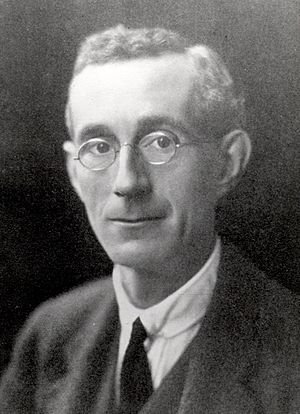Robert John Tillyard facts for kids
Quick facts for kids
Robert John Tillyard
|
|
|---|---|
 |
|
| Born | 31 January 1881 Norwich, England
|
| Died | 13 January 1937 (aged 55) Goulburn, Australia
|
| Alma mater | Queens' College, Cambridge University of Sydney |
| Occupation | Entomologist and geologist |
| Spouse(s) |
Patricia Cruske
(m. 1909) |
| Children | 4 daughters |
| Relatives | Lenox Hewitt (son-in-law) |
| Awards | Clarke Medal (1931) |
Robert "Robin" John Tillyard (born January 31, 1881 – died January 13, 1937) was an English-Australian scientist. He was an entomologist, which means he studied insects. He was also a geologist, studying rocks and the Earth.
Contents
Early Life and Education
Robert Tillyard was born in Norwich, England. He went to Dover College for his schooling. He wanted to join the army, but he couldn't because of a health issue.
He was very smart and won scholarships to study at both Oxford and Cambridge universities. He chose to go to Queens' College, Cambridge and finished his studies in 1903.
In 1904, he moved to Australia. He became a math and science teacher at Sydney Grammar School. While teaching, he spent a lot of time studying and writing about Dragonflies. After nine years, he left teaching to focus on research. He earned a science degree from the University of Sydney in 1914.
Scientific Career
In 1914, Robert Tillyard was in a train accident and took some time to recover. In 1915, he became a research fellow in Zoology at the University of Sydney. He then became a lecturer in Zoology in 1917. That same year, he published an important book called The Biology of Dragonflies.
In 1920, he moved to New Zealand to lead the biology department at the Cawthron Institute. Cambridge University also gave him an honorary Doctor of Science degree.
Pest Control Research
In New Zealand, Tillyard became well-known for his work on biological control. This is a way to control plant and insect pests using other living things, instead of chemicals. He famously introduced a small wasp to help control woolly aphis, a pest that harms apple trees.
In 1925, he was chosen as a member of the Royal Society in London. The next year, he published a big book called The Insects of Australia and New Zealand. This book had many pictures and became the main guide for studying insects in Australia and New Zealand for about 50 years. He wrote many articles about different types of insects, including ancient fossil insects.
In 1928, Tillyard returned to Australia. He became the chief entomologist for the Commonwealth Scientific and Industrial Research Organisation (CSIRO). This was a very important job, helping to solve problems caused by insects in Australia. He held this position for six years.
Later Life and Discoveries
During his time at CSIRO, he received several awards. These included the R. M. Johnston memorial medal in 1929 and the Clarke Medal in 1931. In 1935, he was given the von Mueller medal.
After retiring in 1934 due to health reasons, his health improved, and he continued his scientific studies. He was very interested in ancient fossils from South Australia, working with another scientist named Edgeworth David. They published a book about these fossils in 1936. Tillyard believed that studying these old fossils was key to understanding how insects are related to each other.
Robert Tillyard died on January 13, 1937, after a car accident near Goulburn, Australia. He was survived by his wife, Patricia, and their four daughters.
Psychical Research
In the 1920s, Robert Tillyard also became interested in psychical research. This field studies unexplained mental abilities or events. He worked with Harry Price at the National Laboratory of Psychical Research in England. He became a vice-president of the laboratory in 1926.
Tillyard wrote a review of a book about Spiritualism by Arthur Conan Doyle. This caused some discussion in the Nature science journal. Tillyard believed in the possibility of life after death. He even published his observations from attending séances with a medium named Mina Crandon in a 1928 issue of Nature.

